Straight from my Egyptian home, today is all about how to make dukkah–Egypt’s famous blend of nuts, seeds and warm spices. The heady seasoning you never knew you needed! Make this quick dukkah recipe and store it for use as a snack (with bread and olive oil); as a crust for your meats; or as a nutty topping to add texture and flavor to anything from soups and salads, to chicken, fish or roasted carrots.
Be sure to grab my tips and watch the video below.

When a new reader found out I was actually Egyptian, he sent me an e-mail wondering if I can share a dukkah recipe. And you know, I never turn down an opportunity to share about the foods of my childhood. So here we are!
If you’re not familiar with it, let’s just say duqq (another spelling for it) is the condiment you never knew you needed! A secret weapon that will help you add texture and flavor to nearly anything!
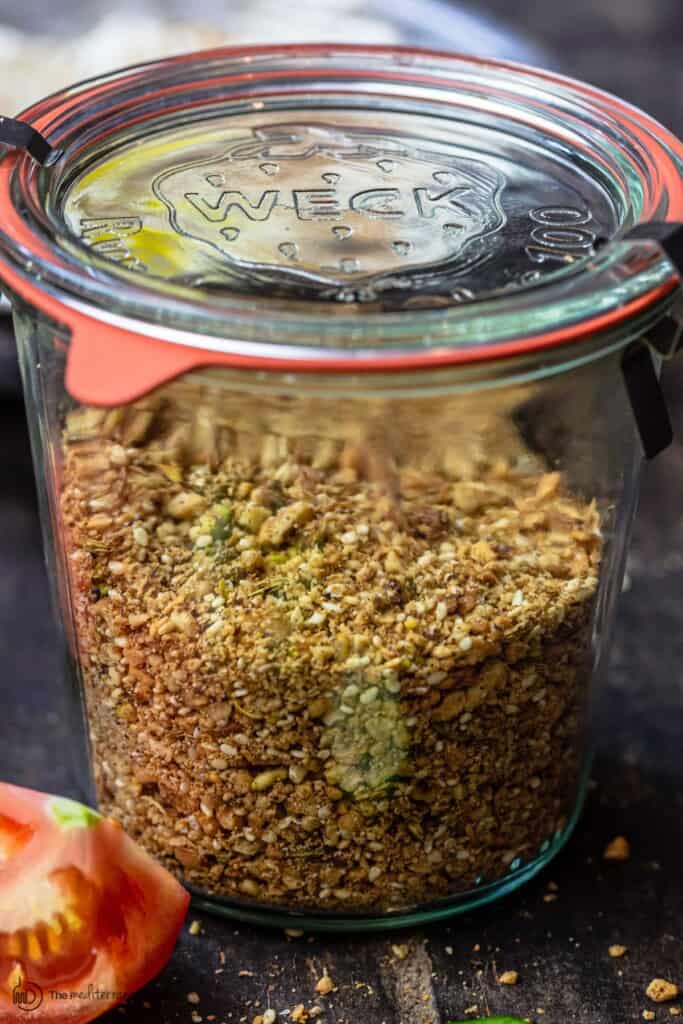
What is dukkah?
Dukkah (duqqa), pronounced doo-kah, is a traditional Egyptian blend of nuts, seeds, and warm spices. It’s been around since the age of ancient Egypt, but it is now widely popular throughout the Middle East and the world (you may have even found a little jar of it at your local grocery store).
Egyptians actually pronounce it dua’ah. And translated from the Arabic, it simply means “to pound.” That’s because traditionally (and in many Egyptian homes today), it is made by pounding a mixture of toasted nuts, seeds and whole spices in a mortar and pestle until they form a coarse, crunchy mixture.
What’s in it?
In Egypt, we have a saying, “eeish we dua’ah,” which literally translates to bread and dukkah–because you can count on a loaf of pita and some nutty, satisfying dukkah for dipping if you have nothing else to eat.
You won’t find pre-mixed duqqa in Egyptian stores or spice shops, this nutty mixture is very much a homemade blend and there are as many recipes for dukkah as there are Egyptian cooks. That’s because the idea behind it is to use up what nuts and seeds you have on hand. (Guess what I do with nuts I didn’t use in my baklava?)
While there are no hard rules, you’ll find some common ingredients. Sesame seeds are a key –they’re cheaper and available in most Egyptian homes– along with warm spices like cumin, coriander and fennel seeds. And you’ll see coarsely chopped nuts like peanuts (again the cheaper option) or hazelnuts, pistachios, or walnuts. You can use one particular nut or a combination as in my recipe here.
Here’s what’s in my recipe…

Dukkah ingredients
- Nuts: Hazelnuts, almonds, and pistachios
- Sesame Seeds
- Fennel Seeds
- Spices: cumin, coriander, and cayenne (leave the cayenne out if you don’t want the heat). Typically the spices are used whole and crushed in the process of making dukkah, but I opted for ground spices here.
- Kosher salt
How do make it?
Great dukkah depends on the freshness of the ingredients, particularly the nuts and seeds. You’ll want to toast your own raw nuts for best flavor. And while traditionally this nutty mixture is made in a mortar and pestle, this easy recipe uses a small food processor (affiliate link). Here is how it goes:
Toast the nuts. Use a dry skillet to toast the hazelnut and almonds until nice and fragrantToast the sesame seeds.
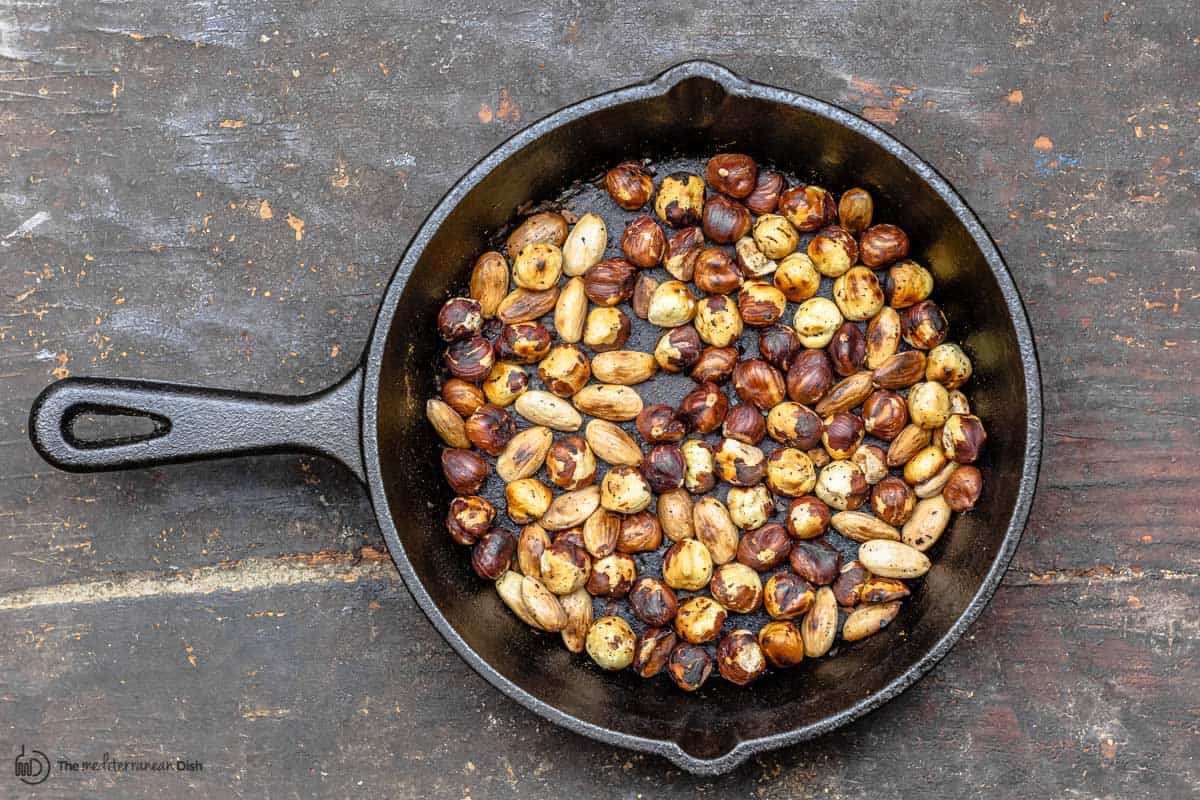
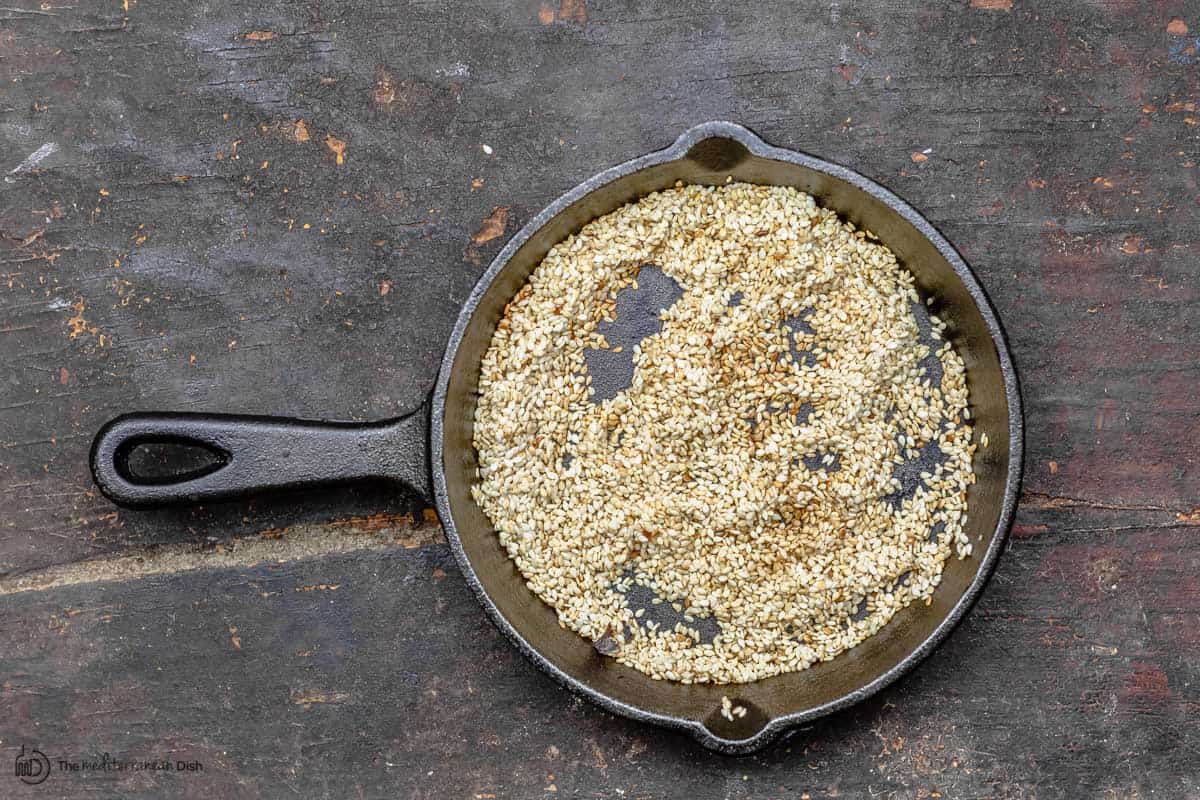
Toast the sesame seeds
Combine the nuts, seeds and spices in the bowl of a small food processor fitted with a blade.
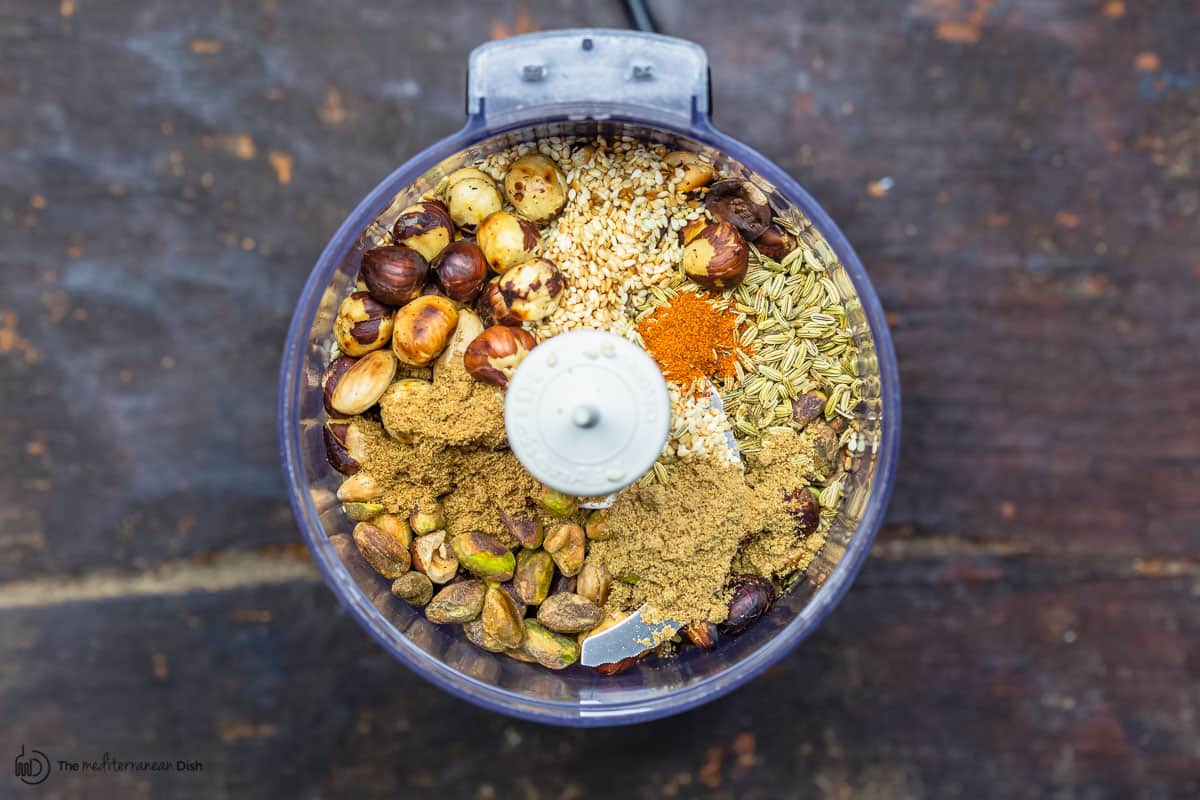
Pulse a few seconds at a time until the nuts are well crushed but don’t overdo it, you’re not looking for a fine powder, you need to maintain the crunch!
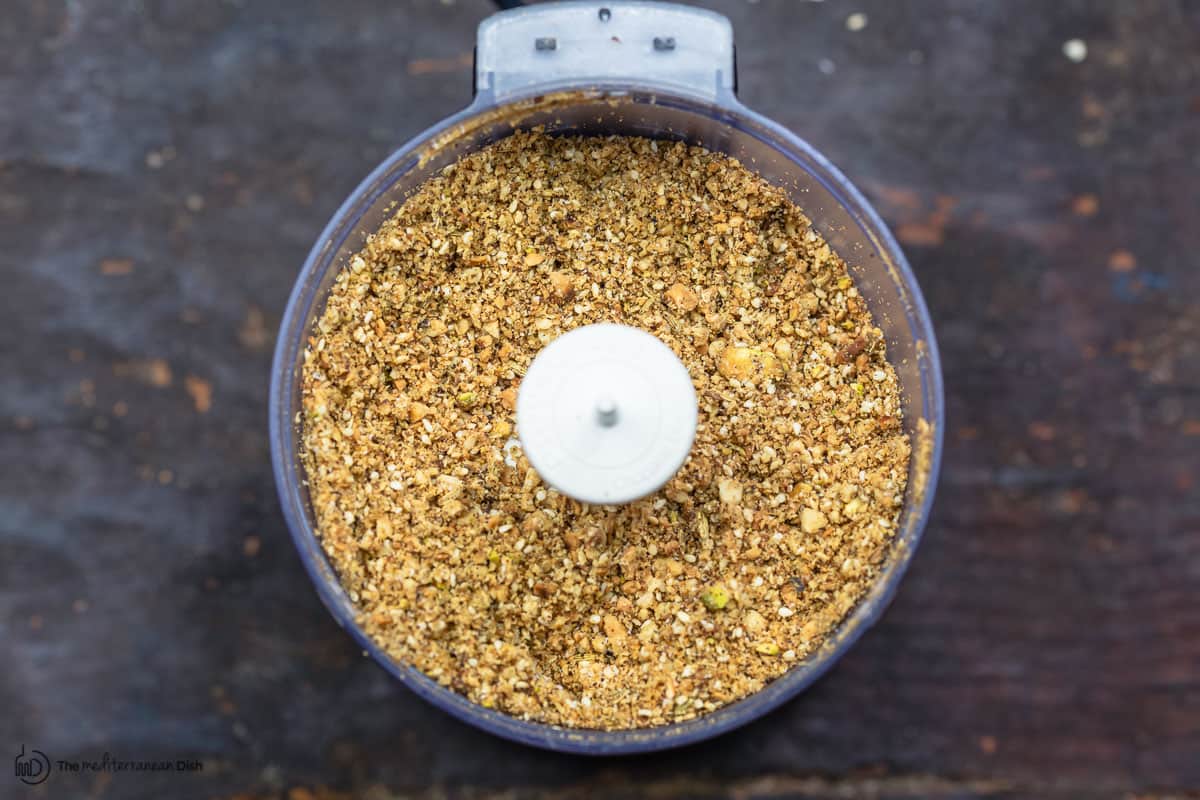
Ways to use it
So many ways to use dukkah seasoning, and I can’t get enough!
- Use it as a dip with your favorite bread (I love it with pita, Jerusalem bagels, or challah bread) and a little extra virgin olive oil
- As a crusty coating for meats, chicken or fish, like this Lemony Dukkah-Crusted Sea Bass With Smashed Peas.
- Add a sprinkle as a finishing touch on dips like hummus or labneh; soup (I love it on this lentil soup); salad; or roasted vegetables…so good on roasted cauliflower

Is dukkah the same as za’atar?
This a frequently asked question and the straight answer is: no. While dukkah and za’atar are two Middle Eastern blends that can be used similarly, they are clearly not the same in texture or flavor profile. If you haven’t already, check out my article on what is za’atar and how to use it. But the short of it is that za’atar blend is a mixture of toasted wild thyme and sesame seeds with sumac.
Za’atar blend has a finer mixture than crunchy Egyptian dukkah.
You may also enjoy 50+ Top Mediterranean diet recipes. For all recipes, visit us here. JOIN MY FREE E-MAIL LIST HERE.
Egyptian Dukkah Recipe

Ingredients
- 1/2 cup hazelnuts
- 3 tbsp almonds
- 4 tbsp white sesame seeds
- 3 tbsp shelled pistachios
- 1 tbsp fennel seeds
- 1 tsp ground cumin
- 1 tsp ground coriander
- 1/2 tsp cayenne pepper
- kosher salt
Instructions
- Place the hazelnuts and almonds in a dry cast iron pan (do NOT add oil). Toast briefly over medium-high heat, tossing regularly, until the nuts gain some color (watch for nuts to turn a nice golden brown). Transfer to a side dish for now.
- Place the sesame seeds in the same skillet and return to the heat. Toast over medium heat, tossing regularly, until the sesame seeds turn golden brown (this will be fairly quick so watch carefully).
- Add the toasted nuts and sesame seeds to the bowl of a small food processor fitted with a blade. Add the pistachios, fennel seeds, spices, and a generous dash of kosher salt. Pulse for a few seconds until you reach a nice coarse mixture (Do not over process the dukkah. The mixture should not be too fine. See photos and video for exact texture).
- Transfer the dukkah to a bowl to serve. Add a small bowl of extra virgin olive oil and your favorite bread for dipping (I like pita bread or even Jerusalem bagel). You can also store the dukkah in a tight-lid jar for up to 2 weeks to use as a topping for salad, soup, chicken, meats, or roasted vegetables!
Video
Notes
- Yield: This recipe makes just over 1 cup of dukkah.
- Storage: Store dukkah in a tight-lid mason jar for up to 2 weeks.
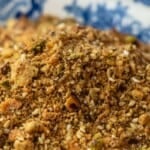


I used this with your roasted cabbage with dukkah and tahini. Delicious! Thank you
Can you leave out the coriander ? Or replace it?
Hello! I’ve never tried this one without coriander, but I think it would be okay to just omit it and maybe compensate by adding more of the other seasonings. It won’t quite have the same flavor profile as traditional Dukkah, but it will still be delish!
What about toasting the other seeds, like the fennel and cumin etc? Would that improve the flavour of the seeds?
Hi, Emma. Just a note, the cumin here should be ground. And the fennel seeds can be toasted, it’s just not something we’ve tried before so I can’t say if it would do much to improve the flavor of the rest of the seeds. I highly recommend trying this recipe as written first… it’s delicious! You can always play with it from there if you think it’s necessary.
Ah! The beautiful Nefertiti of the kitchen, your recipe sounds great, the video was wonderful. I’ll be back to review it!